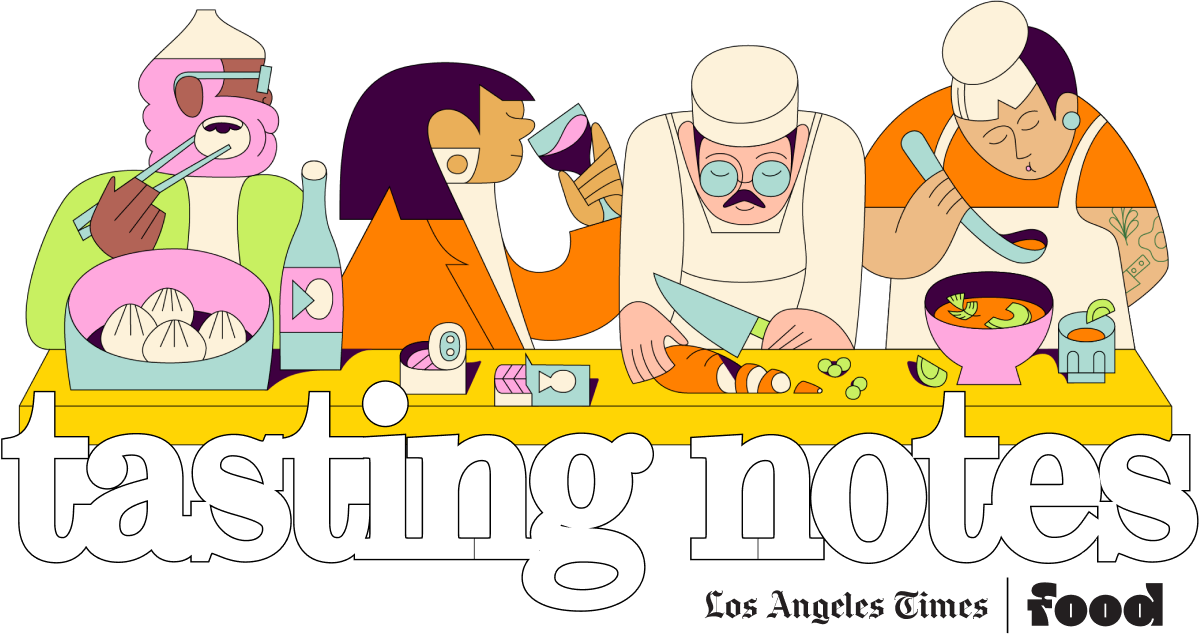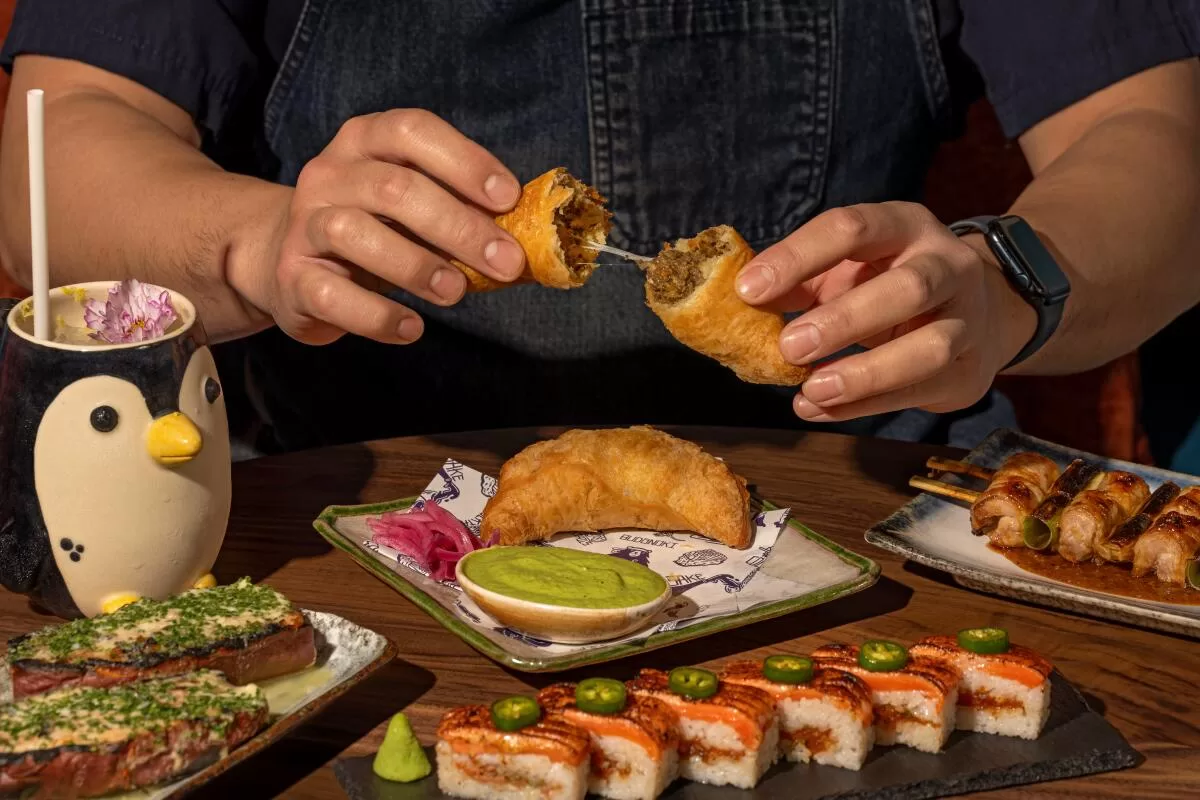Budonoki, from front-of-house pros Eric Bedroussian and Josh Hartley and chef Dan Rabilwongse, draws on the idea of izakaya as its model: sake, served by the glass or bottle and as the base for clever, gulpy cocktails; and a menu of snacky dishes, including a riff on curry pan that channels empanada in its flaky goodness, chicken oyster yakitori lightly dressed in sauce fragrant with galangal, and herbal Thai sausage paired with crisped rice balls.
The space is moody and urbane in the manner of “Bladerunner 2049,” a 40-seat tableau of shadowed tables, angled bar, paper lanterns and a winding wooden shoji screen bathed in pink and purple lighting. The crowd it attracts makes for a nightly buzzing scene.
What we talk about when we talk about izakaya
Betty — who was born in Aomori and, though she left at age 3, has been a lifelong student of Japanese culture — joined me at my most recent meal there.
“Does Budonoki strike you as an izakaya?” I asked her afterward.
“No,” she said. “I mean, clearly the format of snacks and drinks is inspired by izakaya. But the bumping atmosphere? Izakaya is not so clubby.”
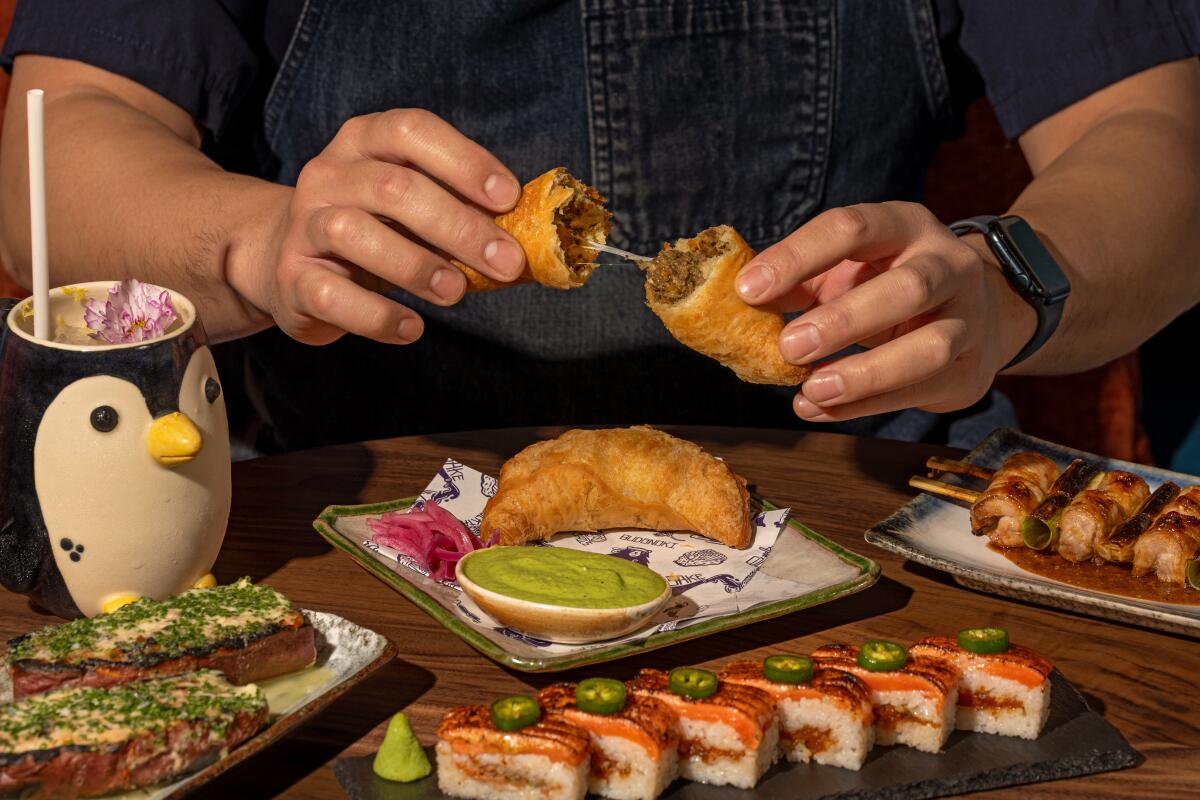
Tearing into curry pan, filled with ground wagyu beef and stretchy cheese, among a spread at Budonoki.
(Ron De Angelis / For The Times)
I pressed on, lobbing out other places in Los Angeles that adapt Californian notions of izakaya.
Courtney Kaplan and Charles Namba’s Tsubaki in Echo Park?
“Love it, but it’s a restaurant,” Betty said.
And their Ototo next door?
“It’s a bar, with food.”
Niki Nakayama and Carole Iida’s n/soto?
“Restaurant.”
Kinjiro in Little Tokyo?
“Izakaya, but a fancy one. It’s not one in the sense of a place you’d drop by for a drink after work.”
Nothing in our conversation aimed to invalidate these businesses, all of which count among the city’s finest beacons for Japanese Californian cooking. But the exchange made me curious to seek out establishments that lean more toward modern concepts of izakaya in Japan.
As with idealized definitions of sushi, the origins of izakaya stem from the Edo Period between 1603 until 1868, when sake shops in Edo (as Tokyo was called before the era’s end) began to prepare small dishes as further enticement to hang around and drink. In the United States I remember contemporary evolutions of izakaya — intentionally casual, handsomely scruffy pubs serving sake and other beverages, with lengthy menus of mostly small plates — having a moment in the early 2010s alongside the pork-fueled heyday of the gastropub.
This is Los Angeles; there is room for everything. We have one of the country’s most profound Japanese dining cultures. If the upscaled Californian izakaya thrives as a genre, the truer-minded counterparts have their own devoted local audiences — as I understood after a week of driving the lengths of the metro area.
Betty gave me some great izakaya advice. So did Tomoko Imade Dyen, a Tokyo-born Angeleno who works as a PR consultant and television producer and who holds occasional, enlightening Japanese tea tastings that I hope lead her to one day open a tea shop. They led me to three standouts I recommend for satisfying immersions into the relaxed, usually boisterous izakaya ethos.
One overall suggestion: Though the essence of izakaya intends an all-around informal experience, it’s still wise to make reservations. In each case I booked tables for a weekday on short notice.
Izakaya Hachi
In Torrance, a seat of Japanese American community that predates World War II, options for soba, tempura, yakitori and certainly sushi (including tiny omakase wonder Sushi I-naba) present themselves block by block. Conversations around izakaya in the area tend to begin with Hachi, the anchor of a strip mall on wide, busy Carson Street. An international restaurant conglomerate operates the place — and a sister location in Costa Mesa — but there is no hint of corporate sheen.
Knotty tables and a short dining counter fill the small room, which inevitably grows crowded by early evening. Servers move fast, delivering and clearing plates, while groups of predominantly Japanese-speaking customers take their time sipping sake or Sapporo on tap and sharing a spread of dishes.
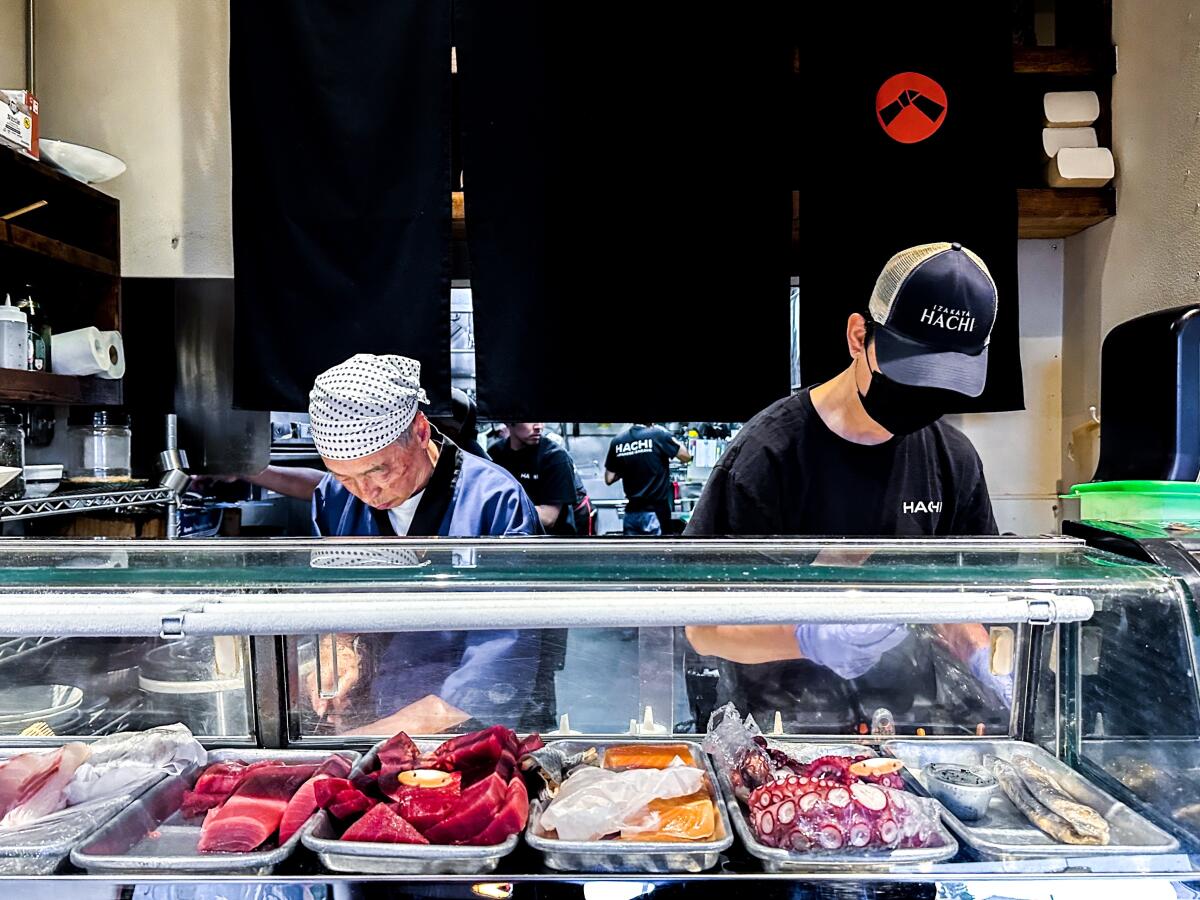
Chefs work behind the sushi counter at Izakaya Hachi in Torrance.
(Bill Addison / Los Angeles Times)
The menu is a tabloid-size sheet rolling through sashimi, sushi, warm and cold appetizers, a few salads, meats grilled over the robata, noodles and rice. Maybe all the choices overwhelm at first glance, but the beauty is in the breadth. I have some izakaya rituals: a couple of fried dishes offset with a seaweed salad, pressed sushi rather than nigiri, definitely a few meaty skewers, rice to end the meal. What I appreciate most about Hachi is the energy and the flow. The space rings with voices and clatter but doesn’t deafen. Servers whiz by, dropping off plates in waves: what’s-not-to-like hunks of chicken karaage fried in rippling batter, smoky lamb chops, precisely triangular oshizushi crowned with mackerel, a warming finish of chazuke (rice in dashi) flecked with king salmon. Another glass of sake or lemony chu-hi? My colleague and I never feel rushed, but when we’re ready for the check, it arrives in seconds.
1880 W. Carson St., Torrance, (310) 618-8357, hachius.com
Hakata Izakaya Hero
Chef Hiro Chiya opened his izakaya in the fall of 2019, on a stretch of Westwood especially rich in Persian restaurants and Iranian groceries. The beckoning signage of Pink Orchid bakery nearly overshadows Hakata Izakaya Hero’s modest storefront next door. Not that Chiya is hurting for business. Even on a Monday night his dining room brims with a multigenerational crowd that’s lively to the amiable rowdiness.
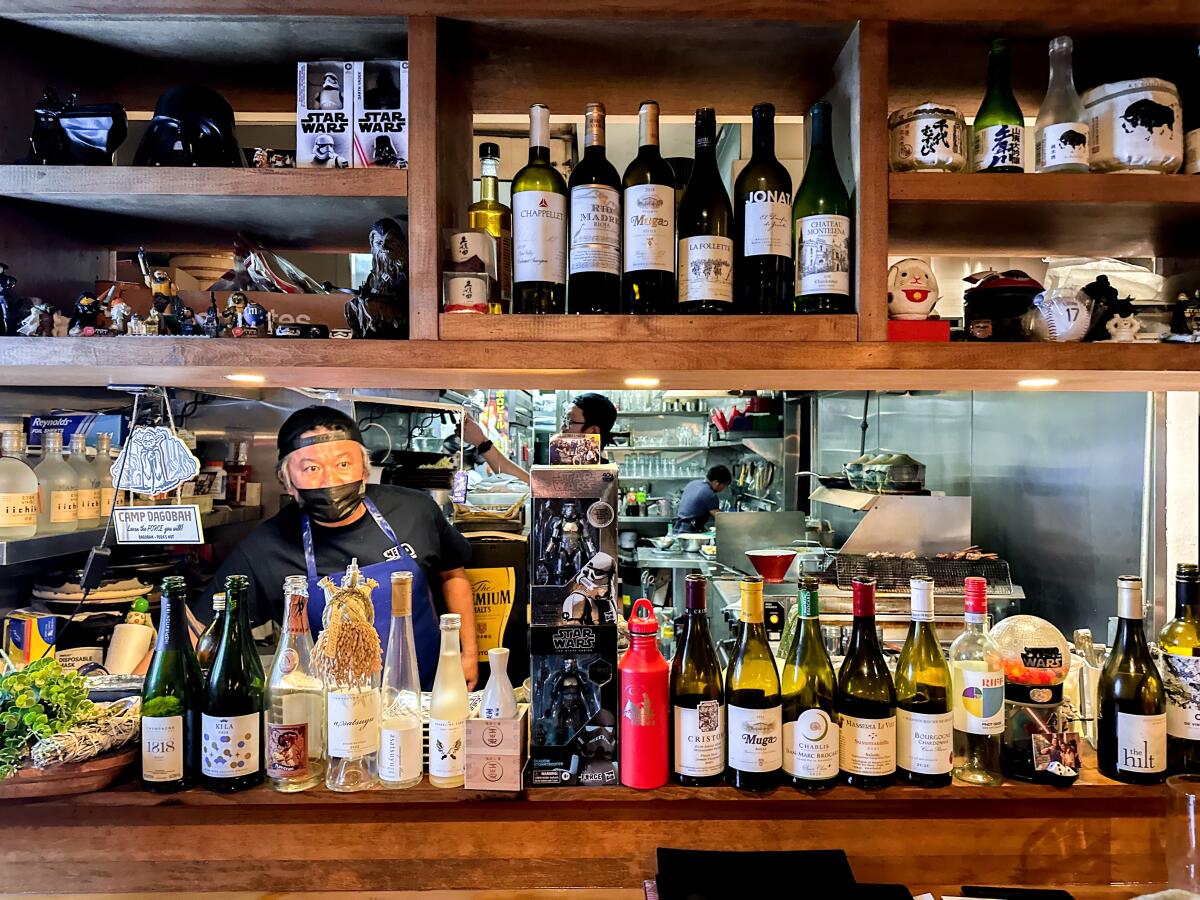
Wine and sake bottles line the kitchen window at Hiro Chiya’s Hakata Izakaya Hero in Westwood
(Bill Addison / Los Angeles Times)
As the menu explains in words and illustrations, the pub’s name refers to the Hakata central district in Fukuoka, the sixth largest city in Japan built on the northern shores of Kyushu island. Among its culinary fortes is tonkotsu ramen, the broth of pork bones (made famous in Los Angeles at specialists like Tsujita) simmered for hours until the liquid basically transforms into meat milk. An extra-intense version fashioned from Black Iberico pork appears frequently on Chiya’s handwritten list of specials, and it’s a wonderful, soporific way to end a meal. Before the finale, two of us powered through teba gyoza (excellent fried chicken wings stuffed with pork-based dumpling filling), cool wilted cabbage scented with yuzu, tempura made from kibinago (small, silvery fish in the herring family that run in the springtime), a second round of tempura with okra and Fukuoka-style pork belly skewers wrapped around a mulchy mix of lettuce, chives, cilantro and scallions. Ask one of the fleet, composed servers about seasonal sake selections, though you can also sip Chateau Montelena Chardonnay alongside tempura and ramen if you’re inclined.
1929 Westwood Blvd., Los Angeles, (424) 832-3304, instagram.com/hakata.izakaya.hero
Izakaya Tonchinkan
When Tomoko mentioned that Yamato Miura, owner of Arcadia destination Sushi Kisen, one of my favorite sushi restaurants across Los Angeles, also operates an izakaya in the strip mall across the street, I didn’t need to hear more. The business sits all but unmarked at the northeast end of the complex, with only a faded wooden plaque bearing its name. Open the door, and you’ll know from the rows of sake bottles and shelves stacked with bowls behind a curving counter that you’re in the right place. Befitting its low profile, the atmosphere is less raucous and more quiet haven.
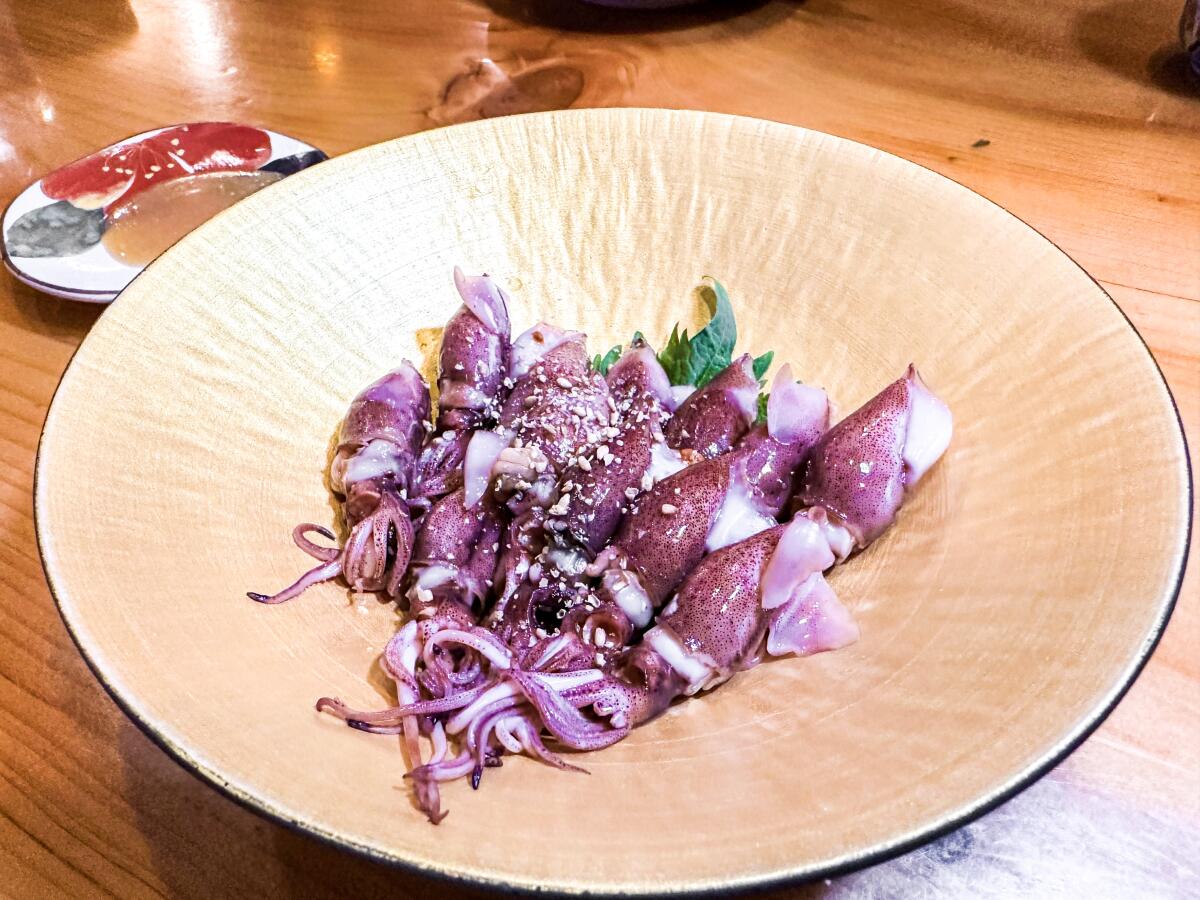
A dish of firefly squid at Izakaya Tonchinkan in Arcadia.
(Bill Addison / Los Angeles Times)
Given the connection to Kisen, it’s no surprise to see that sushi and sashimi occupy an unusually large part of the menu’s real estate, and the freshness of the seafood is duly rewarding. If you’re angling for the most seasonal or sharper-flavored options, ask specifics from the server; a plate of chef’s choice sashimi can arrive with milder, broadly loved tuna and amberjack without detailed requests. A plate of firefly squid with sweet mustard sauce delivered pristine snap in texture and taste; a donabe of rice blanketed with tiny sardines could have used more salt. The showstopper of the evening — and the month, honestly — was hairy crab flown from Hokkaido, cooked and cooled; the legs had been split for maximum ease and brightened with vinegar dipping sauce and a snowy pile of meat was barely scented with yuzu. For $150, divided among four people, it was a worthy splurge. Did it fall into the category of simple, casual izakaya fare? No, but the crab did tease out the citrusy sweetness in our bottle of sake so beautifully it must certainly qualify as drinking food.
713 W. Duarte Rd., Arcadia, (626) 461-5078, tonchinkan.izakaya.la
This weekend is L.A. Times Festival of Books
Did you catch the Food section’s spring cookbook coverage ahead of the L.A. Times Festival of Books this weekend? We’ll have a cooking stage, panels and food authors doing book signings at our L.A. Times x Now Serving booth. Among the authors in our special coverage were José Andrés, Joan Nathan, “Koshersoul’s” Michael Twitty, Kismet chef-co-owners Sara Kramer and Sarah Hymanson, “SalviSoul’s” Karla Tatiana Vasquez, “The Mythical Cookbook’s” Josh Scherer, “Niçoise’s” Rosa Jackson and Jenn Harris’ latest edition of her series “The Crawl” with Grammy-winning producer Benny Blanco, who has a soon-to-be-published cookbook called “Open Wide.”
Also …
Newsletter
Eat your way across L.A.
Like what you’re reading? Sign up to get it in your inbox every week.
You may occasionally receive promotional content from the Los Angeles Times.
